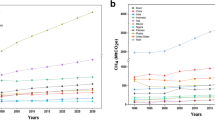Abstract
The rapidly changing global climate due to increased emission of anthropogenic greenhouse gases (GHGs) is leading to an increased occurrence of extreme weather events such as droughts, floods, and heatwaves. The three major GHGs are carbon dioxide (CO2), methane (CH4), and nitrous oxide (N2O). The major natural sources of CO2 include ocean–atmosphere exchange, respiration of animals, soils (microbial respiration) and plants, and volcanic eruption; while the anthropogenic sources include burning of fossil fuel (coal, natural gas, and oil), deforestation, and the cultivation of land that increases the decomposition of soil organic matter and crop and animal residues. Natural sources of CH4 emission include wetlands, termite activities, and oceans. Paddy fields used for rice production, livestock production systems (enteric emission from ruminants), landfills, and the production and use of fossil fuels are the main anthropogenic sources of CH4. Nitrous oxide, in addition to being a major GHG, is also an ozone-depleting gas. N2O is emitted by natural processes from oceans and terrestrial ecosystems. Anthropogenic N2O emissions occur mostly through agricultural and other land-use activities and are associated with the intensification of agricultural and other human activities such as increased use of synthetic fertiliser (119.4 million tonnes of N worldwide in 2019), inefficient use of irrigation water, deposition of animal excreta (urine and dung) from grazing animals, excessive and inefficient application of farm effluents and animal manure to croplands and pastures, and management practices that enhance soil organic N mineralisation and C decomposition. Agriculture could act as a source and a sink of GHGs. Besides direct sources, GHGs also come from various indirect sources, including upstream and downstream emissions in agricultural systems and ammonia (NH3) deposition from fertiliser and animal manure.
You have full access to this open access chapter, Download chapter PDF
Similar content being viewed by others
Keywords
1.1 Introduction
The global climate is changing rapidly. This leads to the increasing occurrence of extreme weather events such as droughts and floods. The major cause of these events is the rising temperature in the Earth’s atmosphere, which is driven by increasing emissions of climate-relevant greenhouse gases (GHGs) that trap heat in the atmosphere. Major GHGs include carbon dioxide (CO2), methane (CH4), and nitrous oxide (N2O) (Fig. 1.1).
Carbon dioxide is the major GHG responsible for the increasing greenhouse effect of the atmosphere. Key natural sources of CO2 include ocean–atmosphere exchange, respiration of animals, soils (microbial respiration) and plants, and volcanic eruption. Major anthropogenic sources of CO2 include burning of fossil fuel (coal, natural gas, and oil), deforestation, and the cultivation of land that increases the decomposition of soil organic matter and crop and animal residues (Xu and Shang 2016).
Aside from CO2, CH4 is a major GHG, which is emitted by natural and anthropogenic processes. Natural sources of CH4 emission include wetlands, termite activities, and occan. Paddy fields used for rice production, livestock production systems (enteric emission from ruminants), landfills, and production and use of fossil fuels are the main anthropogenic sources of CH4. Furthermore, CH4 can be produced by anaerobic mineralization by methanogenic archaea in both natural and man-made systems. Also, plants have been shown to emit CH4.
The third major GHG is N2O (Zaman et al. 2012). Besides being a major GHG, N2O is a major ozone-depleting gas (Ravishankara et al. 2009). Oceans and soils under natural vegetation are non-anthropogenic sources of N2O. However, at a global scale, the emission of N2O is mostly caused by, or related to, anthropogenic agricultural and other land-use activities. The atmospheric concentration of N2O has increased by more than 20% from ~271 ppb to 331 ppb since the industrial era (ca. 1750) to 2018 (WMO 2019). Over the last decade, the rate of N2O increase was equal to 0.95 ppb yr−1 (IPCC 2013b; WMO 2019) with an increasing trend (Makowski 2019; Thompson et al. 2019). In 2006, the total anthropogenic source of N2O was 6.9 Tg N2O-N. Out of these direct emissions, agricultural sources dominated (4.1 Tg N2O-N), while indirect emissions accounted for 0.6 (with a range of 0.1–2.9) Tg N2O-N (IPCC 2016)
Ammonia (NH3) itself has no direct greenhouse effect. It is a gas with a relatively short residence time in the atmosphere (2–10 days) compared to some GHGs, such as CO2 (3–4 years), CH4 (12 years), and N2O (114 years). However, after NH3 is emitted to the atmosphere and reacts with acids, it forms salts. These salts then return to The Earth’s surface and act as a N source source for N2O emissions, similar to a fertiliser-N application. When the soil is submitted to conditions near the optimum for urease activity (e.g. pH close to neutrality, soil moisture near field capacity, temperature >30 ℃), the N losses through NH3 volatilisation from urea-based fertilisers applied on soil surface can be as high as 50% (Martins et al. 2017; Rochette et al. 2013). Therefore, the measurement of NH3 emission is important to estimate indirect N2O emissions derived from soil amendments, such as urea-based fertilisers, green manures, animal excreta, or ammonium-based fertilisers in alkaline soils. A default emission factor defined by IPCC, known as EF4, can be applied for the estimation of indirect N2O emissions derived from volatilisation of NH3 and other nitrogen oxides (NOx) (IPCC 2006). The mean value of EF4, considering the N volatilisation and consequent re-deposition, is 0.01 kg N2O-N per kg N volatilised as NH3 with an uncertainty ranging from 0.002 to 0.05 (IPCC 2006). Therefore, management options that reduce NH3 volatilisation from soils are considered mitigation practices because they reduce indirect N2O emissions (IPCC 2014a; Lam et al. 2017).





